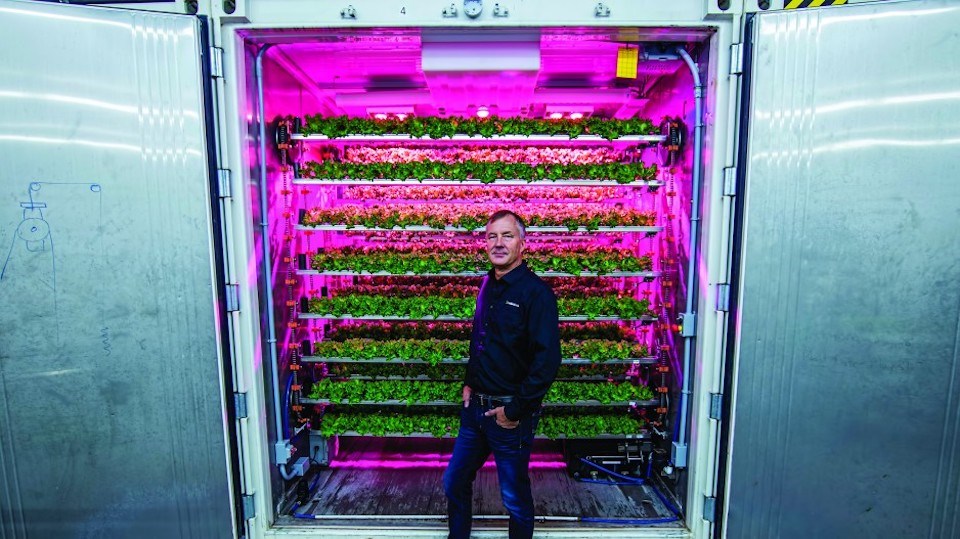Climate change, global supply chain disruptions and labour shortages have combined to create what Dave Dinesen describes as a “perfect storm” for food security.
“Shipping has just been a gong show as of late,” said the CEO of B.C.-based CubicFarms Systems Corp. (TSX:CUB), referring to rapidly rising costs.
“Assuming that you can just grow things far away, and then ship them and they arrive at a reasonable price is no longer a reasonable conclusion to draw. In fact, quite the opposite.”
As surging inflation puts pressure on shoppers in the grocery aisle, made-in-B.C. agricultural technology (agritech) is positioning itself to fill in the gaps for consumers in both the province and beyond.
CubicFarms specializes in indoor growing systems – shipping container-sized units arrayed with LED lights that feature rotating trays that bring crops to workers standing at the front where they tend to the produce inside. Indoor farming allows for crops to be grown 12 months a year, while cultivation is less labour-intensive than sending workers outdoors to face the heat, cold or rain.
A 2019 Royal Bank of Canada (TSX:RY) report estimates the country’s agricultural labour shortage will to grow to 123,000 positions by 2030.
Last year, CubicFarms received an order from a private investor group for an indoor growing system covering one acre of land within Greater Vancouver.
That system, for example, features 96 double-stacked modules that can produce the equivalent of 100 acres’ worth of salad products grown in a field.
“We are able to grow food locally and get it out to people on a price per meal basis that can compete with importing,” said Dinesen.
“Local growing can help to stabilize local food sources and therefore supply, therefore prices can stay stable. So that is what you’ll begin to see as local indoor farming really begins to take hold.”
The province has been taking initiatives to make vertical farming and indoor farming ventures such as CubicFarms’ more widespread on the West Coast. In February the government updated its Agricultural Land Reserve (ALR) regulations to permit vertical farming.
Instead of spreading crops across vast acres of farmland, this technique can be tapped to grow more crops within a smaller area by allowing them to be grown in stacks layered vertically.
“Historically, it has been challenging for municipalities to attract large-scale agritech companies as there was uncertainty with the ALR regulations,” Abbotsford Mayor Henry, whose community was ravaged by severe flooding throughout its farmlands last fall, said when the province announced the updates to ALR regulations. “By making these changes the provincial government can help this industry thrive, making it easier for orgs, farmers and municipalities to collaborate and innovate.”
B.C. is home to more than 150 agritech companies.
While a 2020 report from B.C.’s Food Security Task Force described nearly all of those companies as “quite small,” some of the larger ones have been drawing increasing interest from well-capitalized global investors.
Vancouver-based SemiosBio Technologies Inc., which specializes in using sensors and data to ensure healthy crops for farmers by monitoring for pests and harmful weather, has raised $200 million from investors over the past two years. About three million Semios sensors have been deployed globally, reporting every 10 minutes to help manage farming operations. For example, its devices can detect and identify agricultural pests and trigger the release of pheromones to thwart their mating.
“What we’ve learned through this pandemic is that we’re already maxed out, and we really cannot afford for our food system to fail for a whole season – that’s just not on the table anymore,” CEO and founder Michael Gilbert told BIV last fall after his company closed its latest $100 million funding round.
Semios went on an acquisition spree last year, scooping up three smaller competitors based in California, Washington state and Australia.
Terms of all three recent acquisitions were not disclosed, but they come as demand for the technology continues ramping up as seasonal weather patterns become harder to forecast, according to Gilbert.
“We can’t control [extreme weather events], but we can definitely do a lot to predict what the impact will be,” he said.
Another one of the larger B.C. firms, Terramera Inc., drew US$45 million in investment capital back in 2019 as part of its effort to reduce synthetic chemicals used in agriculture globally by 80 per cent by 2030.
It’s best known for its flagship chemistry technology, Actigate, which can be licensed to producers of both natural and synthetic pesticides to improve the efficiency, uptake and performance of the active ingredients in crop protection products.
The technology would allow farmers to increase the performance of materials sprayed on agriculture while reducing the overall amount required.
“One of the unfortunate things in the world is that it’s cheap to eat poorly compared to eating well,” Dinesen said.
“Canada is fortunate that we are able to buy food, but there’s certainly lots of people in Canada that are living right on the edge. And as soon as there’s an increase in food price, there’s compromises in other places, [such as] in the quality of the food, the kind of food they’re buying.”



